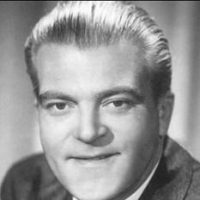
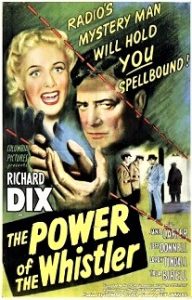 “I am the Whistler, and I know many things, for I walk by night. I know many strange tales, many secrets hidden in the hearts of men and women who have stepped into the shadows. Yes… I know the nameless terrors of which they dare not speak.”
“I am the Whistler, and I know many things, for I walk by night. I know many strange tales, many secrets hidden in the hearts of men and women who have stepped into the shadows. Yes… I know the nameless terrors of which they dare not speak.”
The Whistler (1942-55) aired “Urge to Kill” on October 4, 1942 as the 21st of its 760+ episodes (depending on how one counts). It is only the ninth episode of the show we have run since 2017 and the first since December of last year (2021). For newcomers, introductory background material on the show is reprised below (it was the most popular west coast radio show for many years), with the background providing context for its not totally unique but unusual narrative format.
There were two attempts for The Whistler to break into the east coast market that didn’t last long (July-September 1946, and March 1947-September 1948) due to mediocre ratings, so if these episodes are counted as part of the overall scheme of things, the total number of shows ends up somewhere around 769. Over its thirteen-year west coast run it never took a summer break and ran continuously, certainly some kind of record, and its sole west coast sponsor, Signal Gas & Oil remained loyal throughout. While the show had several narrators over the years, the one who held the longest tenure and is most associated with the show was Bill Forman (photo top right).
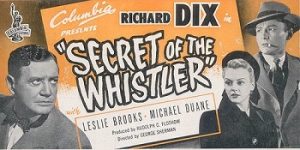
The Whistler has an interesting backstory, and would take much too long to go into here to give it the justice it warrants. A few points of interest will suffice for this offering of the beloved mystery show, the first of which is the use of the narrator as more than just a host. From Jim Ramsburg’s Gold Time Radio entry on The Whistler: “Like The Shadow’s first personification a dozen years earlier, Inner Sanctum’s ghostly Raymond in 1941 and The Mysterious Traveler in 1943, The Whistler stood outside the stories he narrated. Unlike the others, he used a unique second-person, present tense technique as if to talk directly with the central character of his stories – often an innocent drawn into the plot by circumstances or an amateur driven to murder as a last resort.” A second point of interest has to do with the trademark whistling that opens each episode. From Radio Spirits‘ Blog Archive on The Whistler: “The program featured one of radio’s classic openings: a haunting 13-note theme created by Wilbur Hatch (who also composed the show’s eerie mood music). Hatch estimated that only one person in twenty could whistle this exact melody, and for the show’s thirteen-year duration one person pretty much did—a young woman named Dorothy Roberts. In fact, during the war years, Roberts had to get permission from Lockheed (where she worked) to leave her factory job in order to make it to the program and whistle every week.”
The radio show proved popular enough that Columbia Pictures made eight Whistler films from 1944-48, all but one starring Richard Dix: The Whistler (1944), The Mark of the Whistler (1944), The Power of the Whistler (1945), The Voice of the Whistler (1945), Mysterious Intruder (1946), The Secret of the Whistler (1946), The Thirteenth Hour (1947) and The Return of the Whistler (1948). The show was brought to early television in 1954-55, but never caught on. Nevertheless (and due in great measure to roughly 500 of the estimated 700+ original shows still surviving–-and the movies still showing up on classic movie TV channels), The Whistler probably enjoys a larger audience today than it did in its heyday during the Golden Age of Radio.
“The Urge to Kill” is aptly titled. I’m going to hazard a guess that most of us at one time or another during our lifetimes has entertained, at least momentarily as a fantasy and then quickly discarded it, the urge to kill someone or some thing. I think it only natural to mentally walk through the emotions involved in such a scenario, as long as our better angels (our consciences) pull us back from the brink of carrying out such an action in real life. For the vast majority this is how it works for us at the societal level. But for those few who, for whatever reason—psychological, cultural, or in rare cases genetic—it doesn’t, society has a problem. How society deals with this particular reason for murder is an ever-evolving dialogue. In this episode an otherwise successful businessman and husband has reached some inner limit. He goes on midnight walks and does not know where he has been. He forgets important duties and responsibilities at the factory which he co-founded with his longtime partner. The only thing of which he is acutely aware is that at times, and only relatively recently, he has the overwhelming urge to kill. He is aware of these urges and it scares him enough to seek professional help. When this doesn’t appear to help, a short time later his beloved dog is murdered. His wife is about to leave him. He begins to experience bouts of paranoia along with these increasing urges to kill, inventing men having an affair with his wife in one scenario. Is he going insane? What is happening to him? Is he harboring some deep, dark psychological imbalance, and can it be helped through psychotherapy or drugs? Or is there no cure for his anti-social urges of the most heinous sort, and must society then separate him from the rest of civilized humanity? The answer to these questions are answered with guidance from our narrator, the Whistler, as we learn why this severely troubled and potentially dangerous man has been possessed by “The Urge to Kill.”
Play Time: 29:32
{This strange episode of The Whistler aired on a Sunday evening in early October of 1942. As was the case when an episode of any radio show they made sure to listen to was broadcast on a Sunday, the neighborhood gang could hardly wait for school to let out the following day so they could meet at the nearby newsstand and search for those pulp magazines they knew would supply them with the excitement, danger, and thrills the radio show from the night before gave them. Astounding SF (1930-present, now Analog), perhaps not with the most beguiling cover this month, nevertheless included (among others) stories by Lester del Rey, A. E. van Vogt, Murray Leinster, and George O. Smith. As usual, it held to its solid monthly schedule in 1942. Reprinting classic SF and Fantasy stories and novels from before such works would become categorized as “genre,” Famous Fantastic Mysteries (1939-53) enjoyed a successful run by its astute editor, Mary Gnaedinger. It was a valuable resource for older genre classics published in various pulps before magazine SF/F existed, and thus not known to earlier generations of soon-to-be SF/F magazine fans. It published 9 issues in 1942, the first two as bi-monthlies, the last 7 as monthlies. fantastic Adventures (1939-53) was founded by ubiquitous genre publisher and editor Raymond A. Palmer (RAP) as a companion to the highly successful Amazing Stories. One reliable source reports that it ran with lighter, frothier fantasy fare than did Amazing, but by the late 1940s was publishing roughly the same sort of material, though with a more “fantastic” flavor. Among a few other stories, the issue shown below had stories by Nelson Bond, Robert Bloch, and Ross Rocklynne. In 1942 it was a monthly.}
[Left: Astounding, 10/42 – Center: Famous Fantastic Mysteries, 10/42 – Right: fantastic Adventures, 10/42]
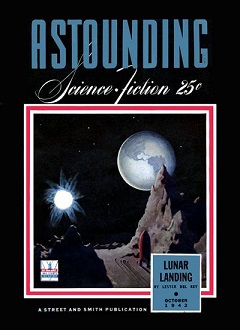
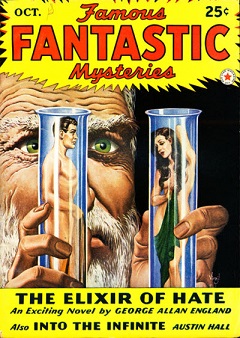
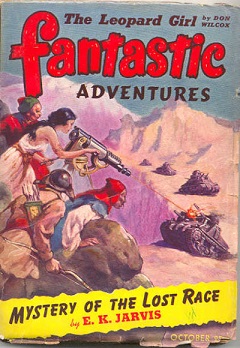
To view the entire list of Old Time Radio episodes go here.